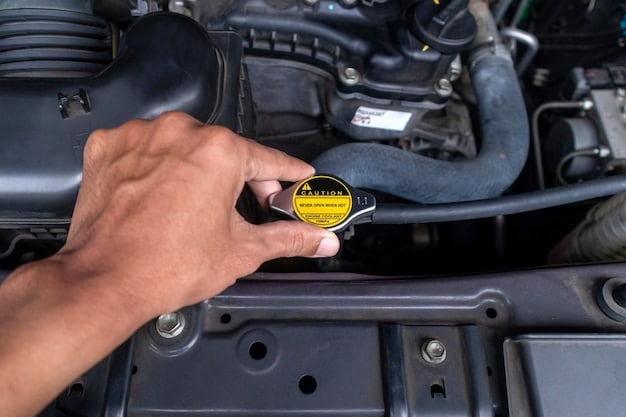Transmission Fluid Check: Why It’s Crucial for Car Longevity

A transmission fluid check is essential for maintaining your car’s performance and longevity, ensuring smooth gear shifts and preventing costly damage to the transmission system. Regularly checking and maintaining the correct fluid level and condition can significantly extend the life of your vehicle.
Ensuring the longevity and optimal performance of your car involves several maintenance checks. Among these, the transmission fluid check stands out as a critical procedure. Ignoring it can lead to severe damage and costly repairs, so understanding its importance is vital for every car owner.
Understanding Transmission Fluid: The Lifeblood of Your Car
Transmission fluid is more than just a lubricant; it’s the lifeblood of your car’s transmission system. It ensures smooth gear shifts, cools the transmission, and protects its internal components from wear and tear. Different types of vehicles require specific transmission fluids, so knowing which one is right for your car is essential.
Types of Transmission Fluid
There are several types of transmission fluid, each designed for specific transmissions. Using the wrong fluid can cause significant damage.
Automatic vs. Manual Transmission Fluid
Automatic and manual transmissions require different types of fluid due to their distinct designs and operational needs.
- Automatic Transmission Fluid (ATF): Formulated with additives to provide lubrication, cooling, and hydraulic pressure for automatic transmissions.
- Manual Transmission Fluid: Typically gear oil with higher viscosity for lubricating gears and bearings in manual transmissions.
- Continuously Variable Transmission (CVT) Fluid: Specifically designed for CVT systems to handle unique friction and lubrication requirements.
Regularly checking your transmission fluid and using the correct type can prevent transmission issues and extend the life of your car.
Why a Transmission Fluid Check is Crucial
A transmission fluid check is a fundamental aspect of vehicle maintenance that often gets overlooked. Regular checks help identify potential issues before they escalate into major problems, saving you time and money in the long run. This simple procedure can significantly impact your car’s performance and reliability.
Preventing Costly Repairs
Neglecting transmission fluid checks can lead to serious damage, resulting in expensive repairs or even complete transmission failure.
Ensuring Smooth Gear Shifts
Clean and properly filled transmission fluid ensures smooth and efficient gear shifts, enhancing your driving experience.

By focusing on this essential maintenance task, you can keep your car running smoothly and avoid unexpected breakdowns. Regular checks mean a healthier and more reliable vehicle.
How to Check Your Transmission Fluid
Checking your transmission fluid is a straightforward process that you can perform at home with minimal tools. Knowing the steps and what to look for can empower you to maintain your car’s health effectively. However, always consult your vehicle’s manual for specific instructions, as procedures can vary between models.
Gathering Necessary Tools
Before you begin, ensure you have the necessary tools, including a clean rag or paper towel and your vehicle’s owner’s manual.
Step-by-Step Guide to Checking Fluid Levels
Follow these steps to accurately check your transmission fluid level and condition.
- Locate the Dipstick: Consult your owner’s manual to find the transmission fluid dipstick, usually marked with a transmission symbol.
- Prepare the Dipstick: Remove the dipstick, wipe it clean with a rag, and reinsert it fully.
- Check the Fluid Level: Remove the dipstick again and check the fluid level against the “full” or “add” marks. Ensure the level is within the recommended range.
- Inspect the Fluid Condition: Examine the fluid for color and odor. Healthy fluid is typically red or light brown and has a slightly sweet smell.
By following these steps, you can easily monitor your transmission fluid and address any issues promptly.
Interpreting Transmission Fluid Condition
The condition of your transmission fluid can tell you a lot about the health of your transmission system. Knowing what the different colors and smells indicate can help you identify potential problems early on. Regular inspections can prevent minor issues from turning into major headaches.

Color and Smell Indicators
Different colors and smells can indicate various issues with your transmission fluid and overall transmission health.
Addressing Abnormal Fluid Conditions
If you notice any abnormal conditions, such as dark fluid or a burnt smell, take immediate action.
Paying attention to these indicators and acting promptly can save you from costly repairs and ensure your car’s longevity.
When to Change Your Transmission Fluid
Knowing when to change your transmission fluid is essential for maintaining your car’s performance and longevity. The frequency of fluid changes depends on various factors, including driving conditions, vehicle type, and manufacturer recommendations. Consulting your owner’s manual is always the best way to determine the specific needs of your vehicle.
Factors Affecting Fluid Change Intervals
Several factors influence how often you should change your transmission fluid.
Following Manufacturer Recommendations
Adhering to the manufacturer’s recommended service intervals is crucial for maintaining warranty coverage and optimal performance.
By understanding these factors and following manufacturer guidelines, you can ensure that your transmission fluid is changed at the appropriate intervals, keeping your car running smoothly.
The Consequences of Neglecting Transmission Fluid
Neglecting your transmission fluid can lead to a host of problems, ranging from decreased performance to complete transmission failure. Understanding these consequences can motivate you to prioritize regular checks and maintenance. The cost of neglecting this essential task far outweighs the expense of routine fluid changes.
Common Transmission Problems
Ignoring transmission fluid maintenance can lead to several common issues.
Long-Term Damage and Costs
The long-term effects of neglecting transmission fluid can result in significant financial burdens and inconvenience.
- Decreased Fuel Efficiency: Dirty or low transmission fluid can reduce fuel economy.
- Transmission Slippage: Worn-out fluid can cause gears to slip, leading to erratic performance.
- Overheating: Inadequate lubrication can cause the transmission to overheat, damaging internal components.
- Complete Failure: Severe neglect can result in total transmission failure, requiring expensive replacement.
Recognizing these potential consequences underscores the importance of regular transmission fluid checks and maintenance.
Choosing the Right Transmission Fluid
Selecting the correct transmission fluid is critical for ensuring optimal performance and longevity. Using the wrong type of fluid can cause damage to your transmission system. Always refer to your vehicle’s owner’s manual for specific recommendations. Doing so will ensure that your transmission operates smoothly and efficiently.
Understanding Fluid Specifications
Different vehicles require specific transmission fluids that meet certain specifications.
Consulting Your Vehicle’s Manual
Your vehicle’s owner’s manual is the best resource for determining the correct transmission fluid type and specifications.
Choosing the right transmission fluid not only ensures optimal performance but also helps prevent costly damage down the road.
| Key Point | Brief Description |
|---|---|
| 💧 Fluid Importance | Transmission fluid lubricates, cools, and protects internal components. |
| 🛠️ Checking Fluid | Regular checks can identify potential issues early. |
| 📅 Change Intervals | Follow manufacturer’s recommendations for fluid changes. |
| ⚠️ Neglect Risks | Ignoring fluid maintenance can lead to costly transmission failure. |
FAQ
▼
It’s recommended to check your transmission fluid at least every 30,000 miles or as specified in your vehicle’s owner’s manual. Regular checks can help identify potential issues early.
▼
Healthy transmission fluid is typically red or light brown, clear, and has a slightly sweet smell. Dark, burnt-smelling fluid indicates a problem and the need for a fluid change.
▼
No, you should only use the transmission fluid specified in your vehicle’s owner’s manual. Using the wrong type can cause damage to the transmission system.
▼
Signs of low transmission fluid include difficulty shifting gears, slipping gears, unusual noises from the transmission, and the transmission warning light illuminating on the dashboard.
▼
Changing transmission fluid can be complex, depending on the vehicle. It’s often best left to a professional mechanic, but some car owners with experience may do it themselves.
Conclusion
In conclusion, performing a regular transmission fluid check is a simple yet crucial task that every car owner should prioritize. By understanding the importance of transmission fluid, knowing how to check its condition, and following recommended maintenance schedules, you can ensure your car’s transmission system operates smoothly and reliably for years to come, avoiding costly repairs and maintaining optimal performance.





